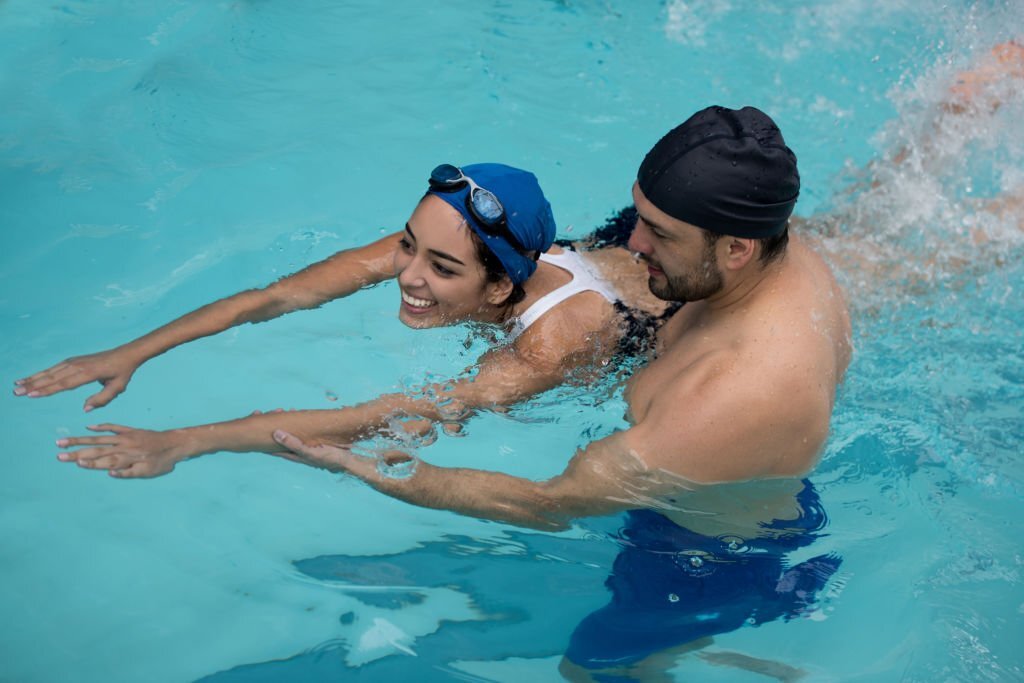Swimming is not only a great form of entertainment, but it is also a vital human skill. Your self-assurance physical fitness and access to a variety of water-relate hobbies can all be enhanced by taking swimming lessons. It is never too late to learn to swim, regardless of your age. There are numerous swimming classes available that give expert services to learn to swim. If you reside in Kuala Lumpur and want to learn to swim, Swim Up Academy is one of the best options. Swim Up consistently emphasizes the value of swimming instruction for beginners. They are committed to providing the greatest swimming curriculum and a highly qualifies coach for your education. Let’s discuss every step of learning to swim in this comprehensive manual, from overcoming fear to mastering various techniques.
How to Dress for Swimming Exercises
There are a few things you’ll need before diving into the water:
Swimsuit
While picking a look, keep in mind that loose-fitting, baggy clothes will make you appear heavier. Find a swimsuit that fits snugly. Instead of baggy swim trunks for guys, experts advise wearing a suit style called “jammers” (they resemble cycling shorts). Pick a swimsuit for women that offer the sort of coverage you desire.
Swimmer’s Cap
If you want to protect your hair from your pool exercises, an expert advises investing in a swimming hat. The chlorine in swimming pools may be particularly detrimental to hair, especially light and colour-treated hair. If you want to swim in the ocean. Swimming cap can protect your hair from salt water as well. Although they won’t keep your hair from getting wet, Lycra (a type of cloth) hats can keep hair out of your eyes. The often thinner and less expensive latex caps are another variety. Although they can be challenging to put on and take off. These will protect your hair. The process can be streamline by drying the cap first, followed by the addition of baby powder to keep it from sticking together while it’s not on your head. Silicone is a costlier, thicker kind of cap. These frequently last longer and are typically a little more comfy.
Scuba Diving Masks
A comfortable pair of swimming goggles can protect your eyes from stinging pool chemicals and salt water while also improving your underwater vision. But you don’t want your nose to be hidden by large, scuba-style goggles. As an alternative, seek out a pair that is snug but comfortable and hides the eyes. If you put your face in goggles, shake your head, and don’t let any water in, you should be able to. You’ll need to change the pair and adjust the strap or nosepiece if there is water. If you require them, many of these brands also sell prescription goggles.
Safety Advice for Novices
Swimming has hazards, just like any other form of exercise. To keep secure, follow this professional advice:
Swim With a Partner
Should you never swim alone, regardless of your degree of experience or fitness. Never know what can happen. Might faint, bump against a buoy or the side of the pool with your head. Experience a medical emergency like a heart attack. Consequently, you ought to always swim with a friend or in a body of water that has a lifeguard on duty.
Be Noticeable.
It’s a good idea to always be as visible as possible when swimming, whether it’s indoors or outside. Select swimwear and headgear in vibrant colour. Moreover, a safety buoy is necessary if you are swimming in a lake, river, or ocean. An inflated, brightly coloured safety buoy is a device that you wear behind your feet and is belt to your waist. By doing this, boats and other swimmers can see you more easily. Additionally, it provides you with something to cling to in case you need to stop.
Slowly Increase Your Efforts As You Begin.
You may minimise muscular pain by easing into your swimming exercises. Don’t anticipate breaking any speed or distance records when you first start; stick to two to three swim workouts each week. It is acceptable if you are only able to cross the pool halfway before you need to stop. After going another half-length, get up, bring up a chair against a wall, or do both. Be aware that improving your swimming technique and fitness will take time.
Although swimming is typically a healthy exercise for people of all ages and fitness levels, you should always check with your doctor if you have any health issues or injuries that could cause problems. Additionally, stay away from swimming if you just underwent surgery, have open wounds, or lack the strength to perform the strokes. Swimming is wonderful because it can be done at a very slow speed, and the number of stroke makes it perfect for individuals who have joint pain, minor weakness, or loss of mobility.
Getting Started with a Swimming Workout Strategy
To begin swimming if you are a beginner, you must first take a few steps.
Study Fundamental Water Technical Abilities
Learning fundamental water abilities should come when you feel at ease in the water. Start by blowing bubbles through your lips and nose while keeping your face submerged to practice controlling your breathing. Next, maintain a streamlined posture while tilting your head to the side to practise rhythmic breathing.
Become Familiar with the Water First
The first stage for a newbie or someone afraid of water is to get accustomed to being around water. Start by just standing in the shallow water and work your way up to waist-deep water. Increase the length of time you spend floating and submerging your face in the water. This stage will aid in your development of confidence and comfort in the water.
Include a Section on Water Safety and Proper Breathing
It’s necessary to educate yourself on marine safety and appropriate breathing practices as you advance. Know the significance of following water safety regulations, such as not swimming alone, understanding your limits, and being alert to potential dangers. Inhale before turning your head to the side while swimming, and exhale when your face is underwater to practise breathing skills.
Constantly Look For Training From Professionals.
Nothing matches the advice of a certified swimming teacher, even though this manual offers a thorough overview. If you want coaching that is tailored to your individual need, think about enrolling in classes at a nearby swimming school or hiring a private instructor. For greater trust and diving technique, frequent practice is essential.
Improve your Abilities and Stamina
As your swimming skills improve, concentrate on increasing your endurance and learning new water activities. Swim farther distances or take part in swimming competitions as an effort. To further develop your abilities and love the water, you can also look into participating in water sports like synchronised swimming, diving, water polo, and snorkelling.
Get Assistance and Enjoy the Process:
Although it can occasionally be challenging, swimming can be a rewarding and fun exercise. Embrace a network of people who can inspire and uplift you along the road, such as friends, family, or other swimmers. Remember to enjoy yourself and embrace the procedure of learning to swim.
Final Words
Your physical and emotional health will benefit greatly from learning to swim, which is a life-changing event. As you proceed, make sure to follow this entire advice, be kind to yourself, and have fun. You may learn to glide through the water with ease and skill with perseverance, practice, and the appropriate guidance. To get an expert swim class in Malaysia, you can go through Swim Up Academy. You can easily reach them by searching swimming class near me. Contact them today and have fun swimming!












